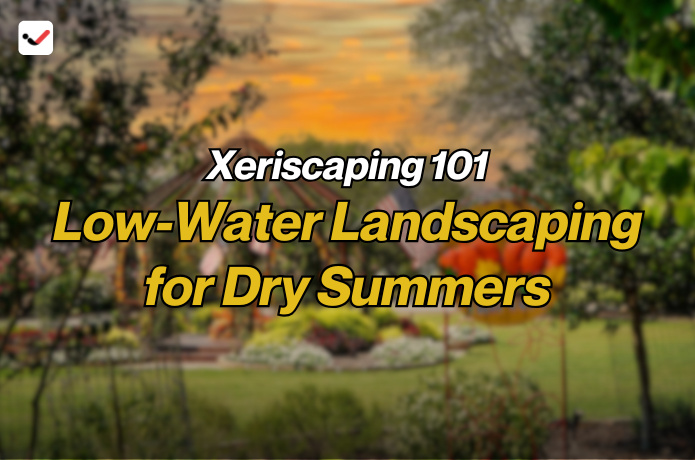Xeriscaping 101: Low-Water Landscaping for Dry Summers
Xeriscaping 101: Low-Water Landscaping for Dry Summers

In many regions, summers are getting hotter and drier. Water bills go up, and lawns turn brown. Traditional landscaping methods just aren’t built for these changing conditions. That’s where xeriscaping comes in. Xeriscaping is a method of landscaping that uses drought-tolerant plants, efficient irrigation, and smart design to reduce water use without sacrificing beauty. It’s a practical, eco-friendly solution that’s growing in popularity, especially in areas with water restrictions or dry climates.
Low-water landscaping not only saves water—it saves time and money too. By choosing the right plants and layout, you can create a landscape that thrives with minimal watering. This guide will walk you through the basics of xeriscaping, including planning, choosing the right plants, improving your soil, and installing efficient irrigation. Whether you’re looking to replace a thirsty lawn or just want to make your garden more sustainable, xeriscaping is a smart way forward.
What Is Xeriscaping?
Xeriscaping is a landscaping technique designed for dry climates. It focuses on water conservation through proper plant selection and design. The word comes from “xeros,” the Greek word for dry. Instead of relying on constant watering, xeriscapes use native plants, mulch, and smart irrigation to create a thriving yard that works with the environment, not against it.
This method is ideal for anyone living in areas with limited rainfall, frequent droughts, or rising water costs. Xeriscaping can be used in residential gardens, commercial properties, parks, and even city medians. It’s all about designing a landscape that uses less water while staying attractive year-round.
Benefits of Xeriscaping
One of the biggest benefits of xeriscaping is water conservation. Traditional lawns require thousands of gallons of water each year. Xeriscaped yards can cut that usage by more than half. This not only lowers your water bill but also helps protect local water supplies.
Another major benefit is reduced maintenance. Lawns need regular mowing, fertilizing, and watering. In contrast, low-maintenance landscapes use hardy plants that grow slowly and need little care. This means less time spent on yard work and more time enjoying your space.
Additionally, xeriscaping supports local ecosystems. Native and drought-resistant plants attract pollinators like bees and butterflies. They also provide habitats for birds and other wildlife, creating a balanced, natural environment.
Start with a Plan
Before pulling out plants or laying gravel, start with a landscape plan. A clear layout helps you make smart choices about how to use your space and where to place certain plants. Look at how much sun and shade each part of your yard gets. Check the slope and drainage. These factors will help determine which plants will grow well in each spot.
Consider replacing high-water areas like lawns with drought-tolerant ground covers, decorative rocks, or hardscaping like patios or paths. Design your xeriscape so it fits your lifestyle—maybe a seating area for relaxing, a garden bed with herbs, or a shady spot for pets.
Choose Drought-Tolerant Plants
Selecting the right drought-tolerant plants is key to a successful xeriscape. Native plants are often the best choice because they’re already adapted to local weather and soil. Popular choices for dry landscapes include lavender, sage, succulents, ornamental grasses, and yarrow.
Group plants with similar water needs together. This strategy, known as hydrozoning, helps prevent overwatering or underwatering. Put high-water plants (if you have any) near water sources or shady spots, and use low-water plants for the driest areas.
Avoid traditional lawn grasses, which usually need too much water. If you want a green area, try ground covers like clover, thyme, or buffalo grass. These options use far less water and still provide a lush appearance.
Improve Your Soil
Soil plays a big role in water retention. In dry areas, soil is often sandy or compacted, which makes it hard for water to soak in. Adding organic matter like compost can help the soil hold moisture longer and support healthy plant growth.
Mulching is another essential technique. Spread a layer of mulch—like wood chips, bark, or gravel—around your plants. Mulch keeps the soil cool, reduces evaporation, and helps block weeds. It also adds nutrients to the soil as it breaks down.
Water Smart, Not More
Efficient irrigation is a major part of water-wise landscaping. Instead of spraying water all over your yard, use drip irrigation or soaker hoses. These methods deliver water directly to plant roots, where it’s needed most, reducing waste from evaporation and runoff.
Water early in the morning or late in the evening to minimize loss to the sun. Also, water deeply but less often. This encourages roots to grow deeper, making plants more drought-resistant over time. Installing a timer or smart irrigation system can help you manage water use automatically.
Add Hardscaping and Design Features
A good xeriscape isn’t just about plants. Add hardscape features like stone paths, gravel beds, or raised garden beds to break up space and reduce watering needs. Patios, benches, and decorative boulders can also add function and style.
Use color and texture to keep your landscape interesting. Even without bright green grass, you can create a beautiful yard using different plant shapes, flowers, and foliage. Don’t be afraid to mix in sculptures, pots, or dry stream beds for visual appeal.
Maintain Your Xeriscape
Once established, xeriscapes are easy to care for. You’ll still need to check your plants regularly, especially in the first year. Weed control is important—use mulch and hand-pulling to keep weeds in check without chemicals.
Prune dead or overgrown plants to keep things tidy. Check your irrigation system now and then for leaks or blockages. Over time, you’ll find that your xeriscape becomes self-sustaining, needing far less attention than a traditional yard.
Xeriscaping is a smart, sustainable way to create a beautiful landscape that saves water, money, and time. It’s ideal for dry summers and perfect for areas facing drought or rising utility costs. By planning well, choosing the right plants, and using efficient watering techniques, you can enjoy a low-maintenance yard that works with nature—not against it.
If you’re ready to reduce your environmental impact and take control of your water use, xeriscaping is a great place to start. It’s practical, effective, and better for the planet. Your yard can look great and thrive, even in the hottest, driest months of the year.

